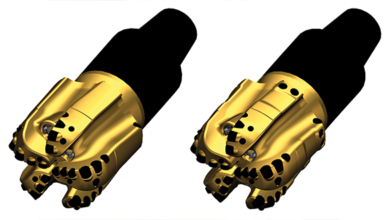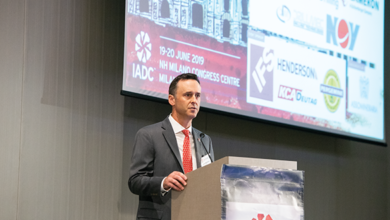Drilling & Completion News
Transocean wins 5-year contract for new drillship
Transocean has signed a rig design and construction management contract, as well as a five-year drilling contract, with Chevron for one of its two dynamically positioned ultra-deepwater drillships under construction at the Jurong shipyard in Singapore. The contract has an estimated backlog of $830 million, excluding mobilization and reimbursables. The contract is subject to design, construction and delivery requirements set forth in the construction contract.
The rig will be the first ultra-deepwater floater rated for 20,000-psi operations and is expected to commence operations in the Gulf of Mexico in the second half of 2021.
In the event of termination for convenience by the customer, Transocean will be compensated for its incremental 20,000-psi subsea investment in the rig. Additionally, a termination for convenience occurring after April 2020 would result in a substantial termination fee.
The drillship will feature state-of-the-art technology, including dual 20,000-psi blowout preventers, a net hookload capacity of 3 million lbs, a 165-ton active heave compensating crane and an enhanced dynamic positioning system. The rig’s high-reliability power plant will also be configured to comply with Tier III International Maritime Organization emissions standards.
Rowan announces new contracts, contract extensions
Rowan Companies has announced several new contracts and contract extensions for its rigs. In January, the company announced that the Rowan Norway, an N-Class ultra-harsh environment jackup rig, was awarded a contract in Norway by ConocoPhillips Skandinavia for an estimated duration of seven months, to commence in Q2 2019. The contract award is subject to partner approval.
Further, Shell has extended its contract for the Rowan Gorilla VI jackup in Trinidad. The rig will continue its current drilling program until approximately March 2019, then be used for platform support and accommodations work until approximately September 2019.
In December, Rowan announced two contracts for the Ralph Coffman, a 240-C Class harsh-environment jackup rig. In April 2019, the rig is expected to commence an 180-day contract in Trinidad. After that, the rig will commence a one-well contract from CGX Resources in Guyana for an estimated duration of 60 days.
Exxonmobil to develop west Barracouta gas field
ExxonMobil has made a final investment decision to develop the West Barracouta gas field in the Bass Strait to bring new gas supplies to the Australian market. The project, located in the VIC/L1 block offshore Victoria, is part of the company’s continuing investment in the Gippsland Basin.
The project will be tied back to the existing Barracouta infrastructure offshore in Bass Strait, the first offshore field ever discovered in Australia.
In separate news, ExxonMobil has also begun drilling the Haimara-1 exploration well offshore Guyana, the first of two planned wells in January. The Stena Carron drillship is drilling the well, which is located 19 miles east of the Pluma-1 discovery in the southeast Stabroek Block.
The Noble Tom Madden drillship is expected to drill the second well, Tilapia-1, about 3 miles west of the Longtail-1 discovery. The Tilapia-1 well is located in the growing Turbot area.
Chevron begins production from big foot in GOM
The Chevron-operated Big Foot deepwater project in the US Gulf of Mexico has started crude oil and natural gas production, the company announced in late November. The Big Foot field is estimated to contain total recoverable resources of more than 200 million BOE. The project uses a 15-slot drilling and production tension-leg platform, the deepest of its kind in the world.
Maersk inks deal with Seapulse, awarded options for Maersk Intrepid jackup
Maersk Drilling and Seapulse have signed a master alliance agreement under which Maersk will provide fully integrated services, including provision of drilling rigs, related drilling services, well services, and other goods and services, for a global offshore oil and gas exploration drilling program of 12 wells. The program is expected to commence in mid-2019, with an expected duration of 490 days.

The program spans shallow-water and deepwater wells in several regions, requiring a combination of jackups, semisubmersibles and drillships. The specific rigs to be deployed will be determined on the basis of rig suitability and availability.
The fully integrated services will be provided on the basis of market rates, with an incentive payment scheme to drive performance and provide potential upside for the parties involved in the well program. Maersk Drilling expects to subcontract the majority of the well services.
“The Seapulse business model has the promise to be transformational for the oil and gas industry by optimizing the risks and rewards associated with exploration drilling,” said Jørn Madsen, CEO of Maersk Drilling.
Maersk also recently announced that Equinor exercised two options of two months each for the Maersk Intrepid jackup. The rig is now contracted to Equinor until the end of February 2020. Two options of two months each remain undeclared on the contract.
USGS identifies largest continuous oil and gas resource potential ever assessed
In early December, the US Department of the Interior announced that the Wolfcamp Shale and overlying Bone Spring Formation in the Delaware Basin portion of Texas and New Mexico’s Permian Basin province contain an estimated mean of 46.3 billion bbl of oil, 281 trillion cu ft of natural gas and 20 billion bbl of natural gas liquids. The numbers stem from an assessment by the US Geological Survey (USGS). The estimate consists of undiscovered, technically recoverable resources.
“The results of this most recent assessment and that of the Wolfcamp Formation in the Midland Basin in 2016 are our largest continuous oil and gas assessments ever released,” said Dr Jim Reilly, USGS Director.
This is the first assessment of continuous resources in the Wolfcamp shale and Bone Spring Formation in the Delaware Basin portion of the Permian. The Wolfcamp shale in the Midland Basin portion of the Permian Basin province was assessed separately in 2016. At that time, it was the largest assessment of continuous oil conducted by the USGS. The Delaware Basin assessment of the Wolfcamp Shale and Bone Spring Formation is more than two times larger than that of the Midland Basin. “The results we’ve released today demonstrate the impact that improved technologies such as hydraulic fracturing and directional drilling have had on increasing the estimates of undiscovered, technically recoverable continuous resources,” said Walter Guidroz, Program Coordinator of the USGS Energy Resources Program.
BP plans $1.3 billion phase 3 for Atlantis in US Gulf of Mexico
BP has approved a major expansion at the Atlantis field in the US Gulf of Mexico and has identified significant additional oil resources that could create further development opportunities around the production hubs it operates in the region.

The $1.3 billion Atlantis Phase 3 development is the latest example of BP’s strategy of growing advantaged oil production through its existing production facilities in the Gulf.
The approval for this latest development comes after recent BP breakthroughs in advanced seismic imaging and reservoir characterization revealed an additional 400 million bbl of oil in place at the Atlantis field.
Application of the same technology and analysis has identified an additional 1 billion bbl of oil in place at the Thunder Horse field. Elsewhere, two new discoveries near the Na Kika production facility could provide further tie-back development opportunities.
Atlantis Phase 3 will include the construction of a new subsea production system from eight new wells that will be tied into the current platform, 150 miles south of New Orleans. Scheduled to come onstream in 2020, the project is expected to boost production at the platform by an estimated 38,000 BOED gross at its peak. It will also access the eastern area of the field, where advanced imaging and reservoir characterization have identified additional oil in place.
Over the last five years, BP’s net production in the Gulf of Mexico has increased by more than 60%, rising from less than 200,000 BOED in 2013 to more than 300,000 BOED today.
Future potential developments at BP’s offshore fields in the Gulf include Atlantis Phase 4 and 5, further developments at Thunder Horse, Na Kika subsea tiebacks and Mad Dog field extensions.
Admarine 657’s contract renewed for 7 years
ADES International announced that it has renewed a contract for Admarine 657, an ultra-shallow offshore rig. The renewal for the rig, which is operating in Saudi Arabia, is effective after the expiration of its existing contract during Q1 2019. The renewal period is for seven years, including a two-year option, and is expected to add up to $150 million of backlog.
Talos, Hokchi to cross assign interests in Mexico
Talos Energy and Hokchi Energy have agreed to cross assign Talos’ participating interest (PI) in Block 2 and Hokchi’s PI in Block 31, both in the Sureste Basin offshore Mexico. Talos will assign a 25% PI in Block 2 to Hokchi in exchange for a 25% PI in Block 31. Once the transaction is completed, Hokchi will be the operator of both blocks, and Talos will own a 25% PI on Block 2 and a 25% PI on Block 31. The transaction is subject to approval by the Mexican oil and gas regulator.




